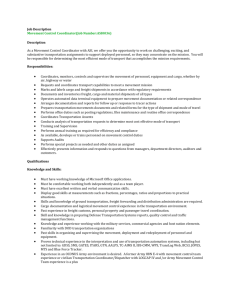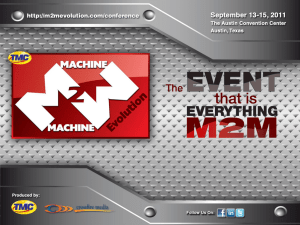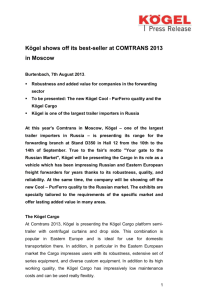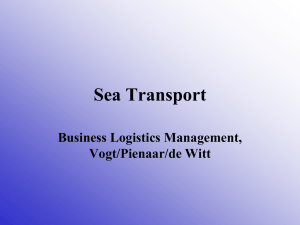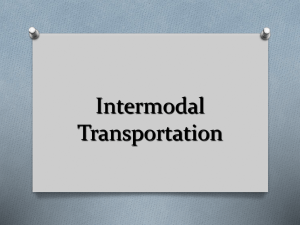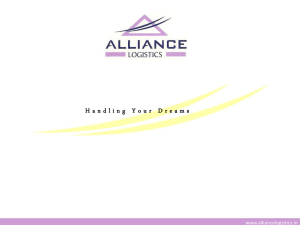TRANSPORTATION LOGISTICS IN THE USA
advertisement
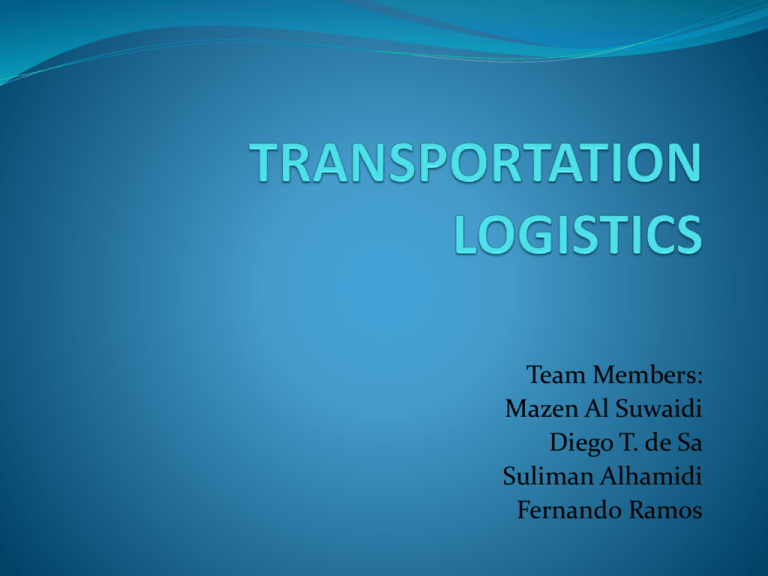
Team Members: Mazen Al Suwaidi Diego T. de Sa Suliman Alhamidi Fernando Ramos Transportation Transportation is the physical movement of goods and people between two points. Each of the five modes of transportation exists because of certain attributes that provide one or more advantages over the other modes of transportation. The attractiveness of a particular mode depends on the following attributes: cost, speed, reliability, capability, capacity, and flexibility. Transportation Modes Airfreight Motor Carrier Ocean Transportation Railroad Pipeline Airfreight Air is generally the fastest mode of transportation for shipments exceeding 600 miles. Air Cargo comprises a large number of daily flights in the United States and are operated by private parcel companies such as FedEx and UPS. Air Freight Capabilities Wearing apparel Electronics Printed matter Machinery and parts Cut flowers and nursery stock Auto parts and accessories Fruits and vegetables Metal products Photographic equipment Airfreight Advantages Make up lost time Perishable products Urgent deliveries Airfreight Disadvantages Expensive Line-haul cost of airfreight service Transportation cost Transit time Increasing handling costs Increasing loss and damage Belly freight Motor Carrier (trucks) The trucking industry provides an essential service to the American economy by transporting large quantities of raw materials, works in process, and finished goods over land, typically from manufacturing plants to retail distribution centers. Motor Carrier Advantages Flexibility Ability to deliver the product to the customer Motor Carrier Disadvantages Limitations by highway weight and size. Speed limitations and hours-of-service (HOS) rules. Highway congestion The Classifications of Motor Carriers Less than truckload (LTL) - The shipments range from about 150 to 10,000 pounds. LTL carriers include Yellow Freight, Roadway, FedEx Freight, and ABF Freight System. The Classifications of Motor Carriers Truckload (TL) - The shipments range grater than 10,000 pounds. TL traffic involve only one customer Prominent TL carriers include Schneider National, J.B. Hunt, Swift Transportation, and Werner Enterprises. Motor Carrier Delay Motor Carrier Delay Weather considerations include fog, snow, flooding, and high winds. Highway congestion which caused by increased travel demand include disabled vehicle, accident, and construction. Cargo Ships A cargo ship, also known as freighter, is one that carries cargo, goods and materials from one port to another. The largest volume of the international trade is carried by thousands of cargo ships through the world’s oceans, seas and lakes. Types of Cargo Ships Bulk Carriers These ships are designed to transport unpackaged bulk cargo such as cement, ore, grains and coal. 40% of the world’s merchant fleets. Types of Cargo Ships Container Ships These cargo ships carry intermodal containers that can be carried by land. Containers vary from 20 to 40 feet in length. Types of Cargo Ships Lake Freighters (Lakers) Lakers are bulk carriers that transport goods through the Great Lakes. • The number of Lakers in operation has been reduced due to the Saint Lawrence Seaway, that allows access of oceangoing vessels to the Great Lakes. Unloading Container Ships Port cargo cranes are used to unload containers from cargo vessels. The Panama Canal A narrow land bridge between North and South America offered a way of creating a passage between the Atlantic and Pacific Oceans. The Panama Canal The Panama Canal was built by the United States in 1914 after a failed attempt by the French. It has become a fundamental link for the shipping industry. Ocean Transportation The shipping industry is one of the largest employers in the nation. The largest U.S. ports in the eastern sea border are New York-New Jersey, Norfolk, Virginia, Philadelphia and Baltimore. In the Gulf of Mexico, Houston leads. The largest port in the Mississippi is New Orleans. On the west coast, the largest ports are SeattleTacoma, San Francisco, Long Beach and Los Angeles. Railroads Freight trains benefits the nation’s economy, transportation system and environment. However, its use is reduced by lack of flexibility, often by the need of transshipment at both ends of the trip due to lack of tracks to the point of pick-up and delivery. Authorities often encourage the use of cargo rail transport due to its environmental profile. U.S. Domestic Freight Movement Source: TRANSEARCH Rail Types of Freight Services Bulk Unit Train Moves very high volumes of a single commodity Coal, grain, minerals and waste One way (shipper to receiver) Mixed Carload Moves a diverse range of commodities. Chemicals, food products, forest products, metals, auto parts, waste and scrap. One way (shipper to receiver) Intermodal (container, trailer and automobile) Moves truck trailers Almost anything that can be pack in a truck or container like: finished consumer goods, refrigerated foods, tools and parts for manufacturing and raw materials. Two way Example of Bulk Unit Train Example of Carload Train Example of Intermodal Train Railroads Advantages Rail adds transportation system capacity and reduces highway costs Rail promotes economic development and productivity Rail supports international trade Rail is more fuel efficient and generates less air pollution per ton mile than trucks Rail improves safety and security by offering a naturally separated right-of-way for freight. Reduces truck travel, congestions, and highway costs. Railroads Disadvantages Railroads currently are used primarily to haul bulk quantities of cargo and intermodal containers over long distances. Unless a manufacturing facility has a direct connection to the railroad, the remainder of the trip must be handled by truck. With today's demand for “just in time” freight, shipment by rail sometimes cannot meet the rapid and flexible demands of industry. Pipelines One of the advancements humans have made in recent history is the ability to transport liquids and gases via the use of pipelines. Pipelines decrease both the amount of time and labor it would take to displace a liquid or gas from one destination to another. Basic Facts Roughly 200,000 miles of liquid pipeline in the United States. Size from 3 to 48 inch, Lengths 1 to 2000 miles. Constructed mainly of carbon steel What Pipelines Move Crude Oil as raw materials (onshore and offshore) Intermediates/ Chemicals from one location to another in manufacturing CO2 for Enhanced Oil Recovery Finished products- gasoline, diesel, jut fuel, etc.
